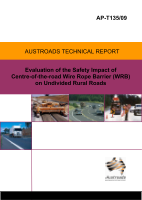Road Design

- Publication no: AP-T135-09
- ISBN: 978-1-921551-32-1
- Published: 1 May 2009
- PDF (free) Download
The benefits of using modern wire rope fences along roadsides as a safety barrier are well documented. Increasingly, this form of safety barrier treatment is being used in wide medians along divided carriageways for new freeways and motorways across Australia and New Zealand. However, wire rope barriers in the centre of undivided carriageways are only now being applied in Australian and New Zealand jurisdictions and the crash and economic value has not been the subject of an Austroads review and evaluation.
This report has examined centre-of-the-road wire rope barrier sites installed along the Pacific Highway in north-eastern New South Wales during 2004, using reported crash data and installation and maintenance costs. The crash data at the subject sites was compared with crash data from matched control sites along the Highway to permit an economic evaluation of this form of road safety treatment. The calculated benefit cost ratios indicate a positive benefit to the community is derived from the application of centre-of-the-road wire rope barriers and ancillary works to accommodate them along the Pacific Highway.
- SUMMARY
- 1. INTRODUCTION
- 1.1. Background
- 2. METHOD
- 3. LITERATURE REVIEW
- 3.1. Development of Wire Rope Barrier (WRB) Systems
- 3.2. Application of WRB Systems Internationally
- 3.3. Sweden’s 2+1 Roads Initiative
- 3.4. Justification of WRB for Centre-of-the-road Treatments
- 3.5. Alternative Treatments for Head-on Crashes
- 3.6. WRB Costs
- 3.7. WRB Design and Operation Issues
- 4. SITE ANALYSIS
- 4.1. Study Site Descriptions
- 4.2. Selection of Control Measures
- 5. STATISTICAL EVALUATION
- 5.1. Data
- 5.2. Discussion of Statistical Analysis
- 5.3. Statistical Evaluation Summary and Conclusions
- 6. ECONOMIC ANALYSIS
- 7. CONCLUSIONS AND RECOMMENDATIONS
- REFERENCES
